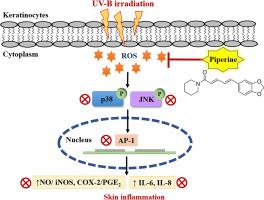Life Sciences ( IF 6.1 ) Pub Date : 2020-10-19 , DOI: 10.1016/j.lfs.2020.118607 Yamaratee Jaisin , Piyanee Ratanachamnong , Orapin Wongsawatkul , Atthaboon Watthammawut , Kittiya Malaniyom , Sutthibhon Natewong

|
The increase in intracellular reactive oxygen and nitrogen species plays a key role in ultraviolet B (UV-B)-induced inflammatory responses in the human skin. Piperine exhibits many pharmacological benefits. In the present study, the photoprotective effects and the possible underlying mechanisms of the anti-inflammatory effects of piperine on UV-B-irradiated keratinocytes were investigated. Piperine exerted strong, direct scavenging effects on DPPH radicals and exhibited free radical scavenging capabilities as demonstrated by the DCFH-DA and Griess assays. Consistent with these results, 10, 20, and 40 μM piperine pretreatments attenuated UV-B irradiation-induced keratinocyte cytotoxicity as reported by the resazurin assay. The highest concentration of piperine inhibited UV-B irradiation-induced cell apoptosis, as revealed by Hoechst 33342 staining. Moreover, we demonstrated the anti-inflammatory effects of piperine using western blot analysis, real-time PCR, and ELISA. Pretreatment with piperine suppressed the activation of phosphorylated p38, JNK, and AP-1 as well as the levels of COX-2/PGE2 and iNOS synthesis, while UV-B-irradiated cells triggered the induction of these signaling molecules. These results indicated that the inhibition of these inflammatory signaling pathways might play a key role in the regulation of the anti-inflammatory effects of piperine. In addition, piperine showed stronger anti-inflammatory effects than celecoxib which served as a positive control at the same concentration. All these results suggested that the anti-inflammatory properties of piperine protected keratinocytes from UV-B-induced damage, which might be due to its antioxidant properties. Therefore, piperine may be an effective therapeutic candidate compound for the treatment of UV irradiation-induced skin inflammation.
中文翻译:

胡椒碱对UV-B辐射的人HaCaT角质形成细胞的抗氧化和抗炎作用
细胞内活性氧和氮的增加在紫外线B(UV-B)引起的人类皮肤炎症反应中起关键作用。胡椒碱具有许多药理作用。在本研究中,研究了胡椒碱对UV-B照射的角质形成细胞的光保护作用和抗炎作用的潜在潜在机制。胡椒碱对DPPH自由基具有强大的直接清除作用,并表现出清除自由基的能力,如DCFH-DA和Griess分析所示。与这些结果一致,如刃天青测定所报道的,10、20和40μM胡椒碱预处理可减弱UV-B辐射诱导的角质形成细胞的细胞毒性。如Hoechst 33342染色所示,最高浓度的胡椒碱抑制UV-B辐射诱导的细胞凋亡。此外,我们使用蛋白质印迹分析,实时PCR和ELISA证明了胡椒碱的抗炎作用。用胡椒碱进行预处理可抑制磷酸化的p38,JNK和AP-1的活化以及COX-2 / PGE的水平2和iNOS合成,而UV-B辐射的细胞触发了这些信号分子的诱导。这些结果表明,这些炎症信号通路的抑制可能在胡椒碱的抗炎作用的调节中起关键作用。另外,胡椒碱显示出比塞来昔布更强的抗炎作用,塞来昔布在相同浓度下作为阳性对照。所有这些结果表明胡椒碱的抗炎特性保护了角质形成细胞免受UV-B诱导的损害,这可能是由于其抗氧化特性所致。因此,胡椒碱可能是治疗紫外线照射引起的皮肤炎症的有效治疗候选化合物。



























 京公网安备 11010802027423号
京公网安备 11010802027423号